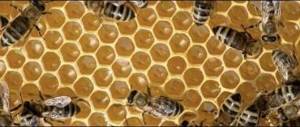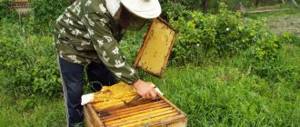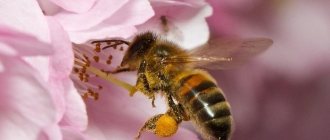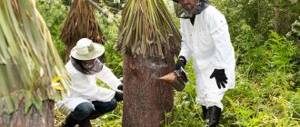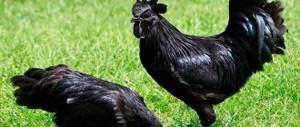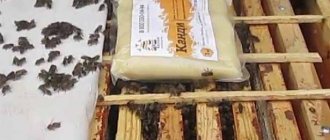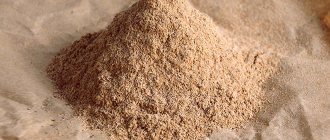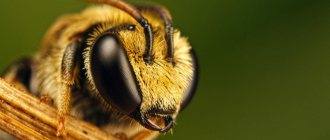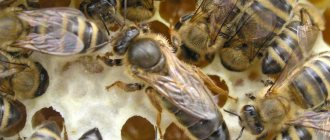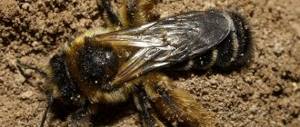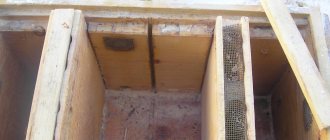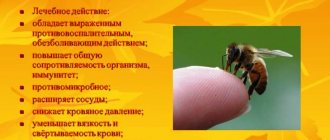Honey is food for all members of the bee family. Insects need food due to significant energy expenditure.
In hot weather, insects actively ventilate the hive with their wings and maintain an optimal climate. In winter, bees have the physiological ability to generate heat when feeding on honey.
When the cold season arrives, the inhabitants of the hive uncork the cells and are saturated with a high-calorie honey product, which provides them with the necessary energy. Insects eat it not only in winter, but also in summer.
In addition to honey, working women need beebread, called “bee bread” - it replaces protein.
Perga
A bee colony may contain more than a couple of thousand individuals that need large supplies for the winter. Due to the fact that insects are thrifty and prudent, most of the bee reserves are a valuable food product for people.
Experienced beekeepers, who care about the well-being of their bee colonies, leave the required amount of honey in the hive for the winter so that the workers can live until spring and not die - the rest is taken away.
Beekeepers, thinking only about profit, immediately collect all supplies, and feed the bees sugar. But this product cannot become a complete food for insects, since they do not receive the necessary vitamins, minerals and enzymes.
Because of this, bees, feeding on syrup, become weak, their endurance and performance are significantly reduced. When warm days arrive, it is difficult for insects to fully begin collecting honey.
The vitamins contained in honey not only help maintain the vital functions of the body, but also ensure the proper functioning of the secretory glands that produce wax, the material used to build honeycombs.
The labor activity of a bee from birth to death:
- For the first three days, she cleans the cell after leaving, putting things in order, so to speak.
- Over the next two days, it flies around the hive, feeding the larvae with pollen and honey.
- From 7 to 11 days, the bee’s glands begin to secrete royal jelly, which they feed the queen larvae and the queen itself.
- From 12 to 17 days, wax glands begin to appear and the small insect begins to turn into a honeycomb builder, guards the hive, maintains the microclimate (flapping its wings), and enjoys nectar.
- From the 18th day, it is time for the bee to collect honey; it goes outside, where it actively produces nectar.
How do bees make honey and turn it into nectar?
A bee returns home with nectar.
The passage of a chemical reaction helps turn the nectar into viscous honey. After the bees return with a stomach full of nectar, the worker insects suck it from the mouth of the field worker with their proboscis.
Some of the bees are left to feed the larvae and young individuals, but the insects chew most of it for some time. This is the chemical fermentation of nectar.
The nectar is exposed to a variety of enzymes that are part of the bees' saliva, turning it into a healthy sweetness.
When processing occurs, excess liquid evaporates, and sucrose, under the influence of a special enzyme (invertase), is broken down into fructose and glucose - they are easily absorbed by the body.
The finished product contains only 5% sucrose. In addition, bee saliva has a bactericidal effect, so supplies can be stored for a long time.
To ensure the evaporation of moisture, the workers transfer the sweet liquid into the honeycombs, filling them 2/3, then begin to actively work on the porches to increase the temperature in the home.
Filling honeycombs with nectar
Receivers place the processed product in special hexagonal cells and seal it with wax lids, which avoids the penetration of air and moisture, as this can lead to fermentation. Further ripening of honey occurs in the honeycombs.
After the moisture is separated, the nectar syrup becomes thick and acquires the consistency of honey.
Insects also store bee bread in honeycombs. The distinctive characteristics of the storage facilities are their shades - honeycombs are predominantly dark yellow, almost brown, and beebreads are predominantly light yellow.
Production lasts from 7 to 14 days. The quality of the product directly depends on the moisture content: the less water in honey, the better it is.
In extreme heat, a sweet liquid secreted by aphids, called honeydew, is added to the nectar. This was the reason why such low-grade honey was given the name honeydew.
Also, sweet plant juice called honeydew can be added to the honey product. Food from honeydew and honeydew is dangerous for bees because it has a negative effect on metabolic processes.
You can see how bees collect honey in an interesting video. Here we talk in detail about how insects collect honey, how they do it, and what happens next:
How are the honey-producing organs of a bee arranged?
Bees have a special proboscis for sucking up nectar. Bees have a special organ called the honey crop. There is a valve between the midgut and it that opens only in case of hunger. The crop is intended for storage and initial processing of nectar. After collection, the bee releases the contents of the crop by regurgitating honey into the honeycomb.
Bee saliva also participates in the formation of honey. When nectar is absorbed, the bee's saliva is found in the crop, which contains useful enzymes for processing. The nectar begins to break down into elements; invertase, glucose oxidase and diastase are involved in this process.
Nectar contains sucrose. Invertase is the enzyme that triggers the conversion of ordinary sucrose into components known to everyone (glucose, fructose).
Glucose oxidase helps to release gluconic acid from glucose (it affects the taste of honey). And hydrogen peroxide is also formed, which protects honey from harmful microbes. Subsequently, the peroxide breaks down.
Stages of honey extraction
Honey collection is the main occupation of bees, so all their work is necessarily aimed at ensuring this process. To do this, all responsibilities are clearly distributed among all members of the bee family.
How does this happen:
- The queen lays eggs , thereby ensuring the extension of the bee family. Scouts go in search of honey plants, and worker bees build honeycombs, collect pollen and nectar. Even newborn bees are busy with work - they feed the larvae, clean the home and maintain the optimal temperature in it.
- Bees extract nectar from the flowers of honey plants. The workers begin work in the spring, when the plants begin to bloom. The scouts are the first to fly out “to hunt” - their well-developed sense of smell allows them to quickly find flowering plants, take nectar from them and return home.
- In the home, bees tell members of their family where the plant is located from which nectar can be collected. Bees communicate using unique dance movements. Next, the scouts and forager bees go to the found location.
- Working women collect honey with their proboscis , which easily penetrates into the flower. Insects can easily recognize the taste of liquid using receptors - they are located on their paws.
- A bee lands on a plant , sucks up nectar with its proboscis, and with its hind limbs, on which special brushes are located, it begins to collect pollen, which it then makes into a ball. This lump is placed in a special basket located on the insect's lower leg. One such ball can be obtained after collecting nectar from many plants.
Bees communicate through dance
Bees are insects that have two stomachs. In one of them, food is digested, and the second serves as a storage facility for nectar accumulation - it holds about 70 mg of nectar.
But if a working woman needs to fly long distances, she spends about 25-30% of her reserves to restore the spent energy.
During the day, a worker bee can fly up to 8 km, but long flights can be dangerous for it. The optimal distance for honey collection is considered to be 2-3 km. In this case, the insect can process about 12 hectares of field.
To fill the nectar collector, a bee needs to fly around about one and a half thousand plants, and to collect 1 kilogram of nectar, it needs to make from 50 to 150 thousand flights.
During honey collection, insects are completely covered in pollen. Then, after flying around, the bees carry pollen and pollinate flowers, ensuring plant reproduction and contributing to high yields.
After filling the collectors with nectar, the collectors return to the hive, where they transfer the nectar to the receiving bees. Insects are engaged in precise distribution: part is left to feed the larvae, the rest is sent for processing.
Receiver bees accept pollen
Honey production technology
Before you start collecting honey, you need to obtain containers for storing the product. A wax hex comb is always created in a hive or wildboard, a perfect design that allows maximum use of volume. They are built by bees. However, the cells are not all the same; they are divided into:
- queen cells, where queens are fed;
- transitional, where larvae grow;
- drones - are built by worker bees and queens;
- bees - a place for storing honey.
How to make a frame for Ruta model hives with your own hands?
It’s clear why bees need honey. The brood needs to be fed and everyone who works to prolong the life of the family needs to stock up on food for the winter.
So, the scout bee found a flowering meadow and flew to the hive, gathering a team for honey collection. The worker bee is a collector of pollen and nectar. Bees begin to make honey as soon as pollen and nectar enter a special crop. Enzymes that break down sugar are also supplied there.
At the same time as nectar, the bee collects pollen with its furry legs, pollinating the plant. The pollen ball is hidden in a basket on the leg, from which beebread will be prepared. In a food warehouse, beebread is stored separately from honey.
In order to fill the crop, a bee needs to collect tribute from one and a half thousand flowers. Having loaded 70 mg into the goiter, the bee flies low, covering the distance to the hive. If the hive is located in the middle of honey plants, fly no more than 2 km, the contents of the crop are delivered to the hive. If further, part of the product is absorbed by the bee to replenish energy. Therefore, apiaries are mobile, moving to where there are many flowers.
Worker bees care for the queen, feeding her and grooming her. For some unknown reason, they can suffocate the uterus in their embrace, taking her into a dense, shrinking ball. Sometimes the beekeeper discovers a sting in the corpse; the queen was killed by her servants, workers, and children.
If you are interested in how bees make honey, watch the video:
The bee transfers honey to the hive and flies away for a new bribe. At the same time, the worker from the hive takes a drop of the brought product several times, draws it into the crop and releases it, she adds invertase from her crop, continuing the fermentation of the nectar. Next, the product is dried, removing excess moisture. It is laid out in a thin layer along the bottom and walls of the cells and the moisture is allowed to evaporate. The humming of bees in front of the hive and inside it is the work of their wings, the ventilation of the hive. The food, dried to a moisture content of 21%, is placed in the top comb and sealed with a wax lid. From the moment the bribe enters the hive until the honey ripens, 10 days pass.
How much honey a bee collects depends on many factors. Bees don't fly in bad weather. If the apiary is far away, the bee can only make one entrance and spend a quarter of the bribe on itself. A healthy family collects up to 150 kg of honey over the summer, half of which is used to support the life of the family. Hard numbers show how hard it is for working women to get sweet products. One foraging bee makes 400 flights in its life, flying about 800 km. For 1 g of honey you need to make 75 flights. One bee can bring 5 g of honey in its life, a spoon. A kilogram of honey is collected by the combined efforts of 200 bees. There can be up to 50,000 individuals in a family. The final result depends on weather conditions, the presence of honey plants and the health of the family.
The worker bee has a much larger brain than the queen bee and the drone.
Features of breeding and amount of honey
The amount of honey collected can vary greatly depending on the region, the location of the apiary, the weather, the breed of bees and their care, and honey plants growing nearby.
If the previous winter was very cold, and spring came late, the bee colony will collect much less product than usual. Favorable conditions (warm and humid air) contribute to the collection of large amounts of honey.
The breed of bees especially affects the volume of honey collection. But when choosing a breed, you need to take into account the region and climatic features of the area. For some regions it is better to choose the Carpathian bee, for others - the Central Russian one.
The size and quality of the hive also affects the amount of product obtained. It is optimal to choose multi-hull houses.
In this case, you need to pay attention to the fact that not all cells are filled with stocks; there should always be free cells available.
It is important that the beekeeper has experience in breeding bees and also properly cares for insects. An experienced beekeeper is able to keep only strong colonies and high-quality, fertile queens.
This way it provides optimal conditions for their life, reproduction and wintering:
- constantly monitors the hive body and its frames.
- installs additional cells;
- prevents bees from swarming and, if necessary, transports the apiary to another area, where there are honey-bearing grasses, shrubs or trees.
Typically, one pumping from the hive allows you to get 13-18 kilograms of a unique product. In very hot or rainy summers, the figures drop significantly - up to 10 kilos. Favorable conditions contribute to the collection of up to 200 kg of healthy sweets from one bee colony.
Honey collection is the main occupation of bees. Insects give their all, devoting their energy to collecting nectar and further preparing honey products.
Each bee from a large family performs specific functions, but they still have a common goal - collecting nectar and processing it into healthy honey.
Why do bees need honey?
We recommend reading our other articles
- Pear variety Clapp's Favorite
- Keeping bees in multi-hull hives
- Cherry compote
- The best varieties of white grapes
How bees make honey was described above, but what do they need it for? Bees literally spend their lives making honey, but why do they need it? Honey is their main food. This is what they eat throughout spring, summer, autumn, but most importantly winter. During warm periods, their bodies can replenish their energy reserves by absorbing and processing nectar, so in the summer they rarely feed on honey. But in winter, when there is neither nectar nor pollen from which a sweet delicacy could be made, this is their main food.
Bee eats honey in winter to support health
The genes of these insects contain thriftiness. Even if there is a lot of honey in the hive, they will still continue to store it so that it lasts longer, because the strength of the bee family depends on it. The hive should be warm all the time. To do this, bees flap their wings, warming the air throughout the winter. If the hive is cold, the larvae and queen may die, followed by the worker bees. Honey replenishes their energy and helps them work more productively.
In winter, a bee colony may die if there is not enough honey; for this reason, in years when honey is poor, beekeepers feed the bees with sweet water or similar products so that the colony survives the cold period.
What affects the quality of honey?
The quality of honey depends on which flowers the nectar is collected from. It may differ in taste, color, smell. The smell is due to the aroma of the plants from which the nectar was taken. Chestnut honey smells like chestnut flowers, for example.
The color depends on the composition of the nectar.
Each flower's nectar has its own impurities. Bees do not particularly separate them - nectar is nectar, but the final honey still turns out to be different colors.
Linden is usually light, buckwheat is dark, and so on. The taste depends on the amount of fructose; the more there is, the sweeter it is. But there are also types that have a bitter taste.
In rare cases, honeydew is mixed with honey. This is a low-quality sweet liquid that is secreted by insects such as aphids and scale insects.
Another similar liquid is honeydew. When these substances get into honey, they reduce its quality. A bee that eats honeydew honey has metabolic processes disrupted, becomes ill and may die.
If bees are left with honeydew honey over the winter instead of high-quality honey, the bee colony may completely die out over the winter.
What factors influence the honey harvest?
Beekeeping is a difficult craft, and it must rely on several components: the geography of the area, good hives available for use, and the breed of bees.
But the amount of nectar that one bee colony can bring depends on many factors:
- Climate in general: air temperature, early or late spring and autumn, severe or mild winter.
- Weather, which has a direct impact on the volume of the flower base. In the dry month, the harvest is minimal, because... There are not enough honey plants.
- Selected location. The honey supply of one hive can be significantly larger than another. Insect health. Strong and strong bees bring many times more honey than weakened ones. Breeds of bees that are more and less productive.
Interesting Facts
- The beekeeper does not calm the bees with smoke , but creates a kind of imitation of a fire. Bees, being the ancient inhabitants of the forest, pounce on honey when smoke appears in order to stock up on it for the long journey. When the bee's belly is filled with honey and does not bend, it cannot use its sting.
- To obtain a spoonful of honey (30 g), 200 bees must collect nectar during the day during a bribe. Approximately the same number of bees should be engaged in receiving nectar and processing it in the hive. At the same time, some bees intensively ventilate the nest so that excess water evaporates faster from the nectar.
- To obtain one kilogram of honey, bees must make up to 4,500 flights and take nectar from 6-10 million flowers. A strong family can collect 5-10 kg of honey (10-20 kg of nectar) per day.
- A bee can fly almost 8 km away from the hive and accurately find its way back. However, such long flights are dangerous for the life of bees and are unprofitable from the point of view of the productivity of their work. The useful flight radius of a bee is considered to be 2 km.
- In one cell of the honeycomb, bees deposit up to 18 pollen weighing 140-180 mg. One average pollen contains about 100 thousand dust particles, the weight of one pollen is from 0.008 to 0.015 g. In summer, pollen is heavier than in spring and autumn. Bees bring up to 400 pollen per day, and during the season a bee colony collects 25-30, and sometimes up to 55 kg of pollen.
